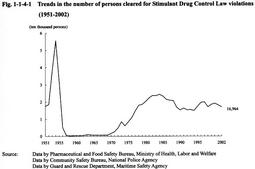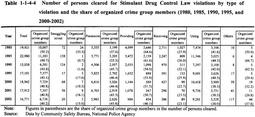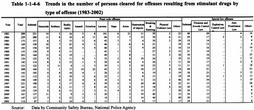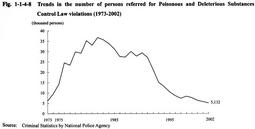| Previous Next Index Image Index Year Selection | |
|
|
1 Trends in drug offenses (1) Stimulant Drug Control Law violations Fig. 1-1-4-1 shows the number of persons cleared for Stimulant Drug Control Law violations from 1951 to 2002. Drug abuse began to become widespread during the chaotic postwar period, and experienced 2 boom periods until now. The number of persons cleared fell sharply after peaking at 55,664 in 1954. As for the reasons behind this trend, it was pointed out that penal regulations were strengthened in 1954 and 1955, that clearance by police was implemented thoroughly, and that educational campaigns concerning the harmful influence of stimulant drugs were held nationally. However, the number of persons cleared took an upward turn again in 1970 and reached 24,372 in 1984, entering the second boom period. From then, it hovered within the 20,000-30,000 range until 1988, but fell below 20,000 in 1989 and decreased to 14,896 in 1994. However, it started to increase again in 1995 and nearly reached 20,000 in 1997, when it entered the third boom period. In 2002, however, the number of persons cleared decreased by 1,146 (6.3%) from the previous year to 16,964.
Fig. 1-1-4-1 Trends in the number of persons cleared for Stimulant Drug Control Law violations (1951-2002) Fig. 1-1-4-2 shows the trends in the number of persons cleared for Stimulant Drug Control Law violations by age group, indicating that the numbers of those in their 20s and 30s have been remarkably large. The number for aged 30-39 was the largest from 1977 to 1984, and subsequently, the number for those aged 20-29 became the largest after 1985 but again those aged 30-39 became the largest in 2002. Juveniles under 20 was over 2,000 from 1980 to 1985, but declined to 749 in 2002 after repeatedly fluctuating. Those aged 50 or over has always been over 1,000 since 1982, surpassing 2,000 in 2000 and 2001.Fig. 1-1-4-2 Trends in the number of persons cleared for Stimulant Drug Control Law violations, by age group (1973-2002) Table 1-1-4-3 shows the trends in the number of persons cleared for Stimulant Drug Control Law violations by type of violation and the number of those who violated the law for profits. In 2002, the number of those cleared for using drugs was the largest with 9,281 persons (55.3%), followed by those cleared for possessing drugs with 5,983 persons (35.7%), which collectively accounted for more than 90% of the total number of persons cleared for Stimulant Drug Control Law violations. The share of those cleared for providing or receiving drugs has decreased every year since 1975, falling to 34.2% in 1980, 24.9% in 1985, 20.0% in 1990, and 10% or below since 2000.The number and share of those who violated the law for profits has decreased every year from 1,549 (7.8%) in 1980 to 437 (2.6%) in 2002. By type of violation, among those who violated the law for profits in 2002, 292 (4.9%) were cleared for possessing and 133 (9.7%) for providing or receiving drugs. Table 1-1-4-3 Trends in the number of persons cleared for Stimulant Drug Control Law violations by type of violation and the share of those who violated the law for profits (1980, 1985, 1990, 1995, and 2000-2002) Table 1-1-4-4 shows the number of organized crime group members (including regular members and quasi-members of organized crime groups; hereinafter the same in this section) cleared for Stimulant Drug Control Law violations, by type of violation. The share of organized crime group members in the number of persons cleared has decreased every year, falling to 6,738 (40.2%) in 2002. By type of violation, the share of organized crime group members was the largest every year for providing drugs, followed by possessing drugs, which indicates that organized crime group members are deeply involved in illicit sales of drugs.Table 1-1-4-4 Number of persons cleared for Stimulant Drug Control Law violations by type of violation and the share of organized crime group members (1980, 1985, 1990, 1995, and 2000-2002) Table 1-1-4-5 shows the number of persons cleared for Stimulant Drug Control Law violations in 2002, by type of violation and nationality, etc. Among those cleared, foreign nationals (including foreign residents in Japan) came to 932, accounting for 5.6% of the total. By nationality, etc., South Koreans had the largest number with 307 persons (32.9%), followed by Iranians with 167 persons (17.9%), Brazilians with 155 persons (16.6%), and Filipinos with 110 persons (11.8%). By type of violation and nationality, etc., most South Koreans, Brazilians, and Filipinos were cleared for using drugs (59.6%, 56.8%, and 53.6% respectively) whereas most Iranians were cleared for possessing drugs (65.9%).Table 1-1-4-5 Number of foreign nationals (including foreign residents in Japan) cleared for Stimulant Drug Control Law violations by type of violation and nationality, etc. (2002) Table 1-1-4-6 shows the trends in the number of persons cleared for offenses resulting from stimulant drugs over the last 20 years since 1983. The persons cleared were over 400 until 1982 (see CD-ROM), but it started to decline rapidly in 1983, falling below 200 in 1985. The number stayed within the 100-200 range since then, except for 1989, 1993, and 1997, and stood at 116 in 2002. By type of offense, Firearms and Swords Control Law violations was the largest in 2002, followed by breaking and entering, and bodily injury. The decline in larceny was remarkable for the last 20 years.Table 1-1-4-6 Trends in the number of persons cleared for offenses resulting from stimulant drugs by type of offense (1983-2002) (2) Narcotics-related offenses Fig. 1-1-4-7 shows the trends in the number of persons cleared for narcotics-related offenses (violations of the Narcotics Control Law, Opium Control Law, and Cannabis Control Law; hereinafter the same in this section) over the 30 years since 1973.
The number of persons cleared for Cannabis Control Law violations rose overall for a long term, despite repeated increases and decreases, and reached 2,103 in 1994. It then fell sharply but started to rise again in 2001, reaching 1,873 in 2002, causing concern over the recent upward trend. Fig. 1-1-4-7 Trends in the number of persons cleared for narcotics-related offenses (1973-2002) (3) Poisonous and Deleterious Substances Control Law violations Fig. 1-1-4-8 shows the trends in the number of persons referred for Poisonous and Deleterious Substances Control Law violations since 1973. The number of persons referred was within the 30,000-40,00 range since 1980 and peaked at 36,796 in 1982. The number then decreased gradually and fell to 5,132 in 2002, about 1/7th of the number at the peak.
Fig. 1-1-4-8 Trends in the number of persons referred for Poisonous and Deleterious Substances Control Law violations (1973-2002) |







